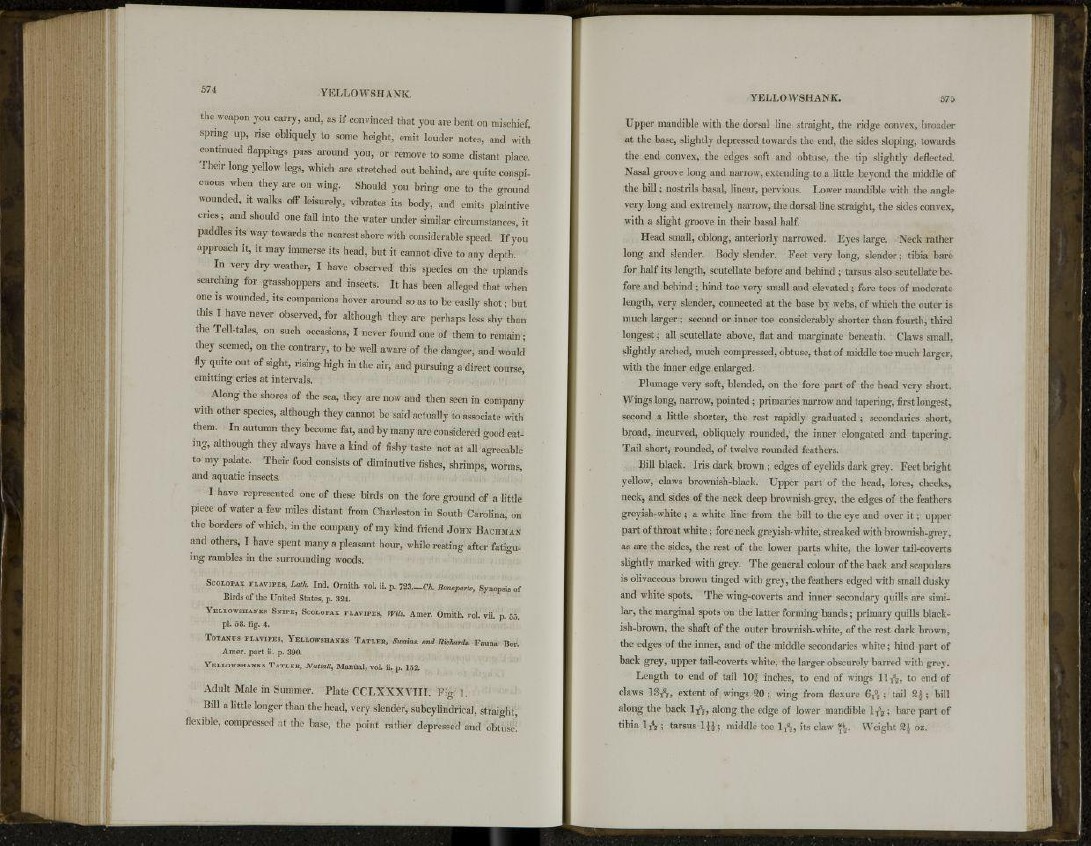
574 YELLO WSH ANK.
the weapon you carry, and, as if convinced that you are bent on mischief,
spring up, rise obliquely to some height, emit louder notes, and with
continued flappings pass around you, or remove to some distant place.
Their long yellow legs, which are stretched out behind, are quite conspicuous
when they are on wing. Should you bring one to the ground
wounded, it walks off leisurely, vibrates its body, and emits plaintive
cries ; and should one fall into the water under similar circumstances, it
paddles its way towards the nearest shore with considerable speed. If you
approach it, it may immerse its head, but it cannot dive to any depth.
In very dry weather, I have observed this species on the uplands
searching for grasshoppers and insects. It has been alleged that when
one is wounded, its companions hover around so as to be easily shot; but
this I have never observed, for although they are perhaps less shy than
the Tell-tales, on such occasions, I never found one of them to remain;
they seemed, on the contrary, to be well aware of the danger, and would
fly quite out of sight, rising high in the air, and pursuing a direct course,
emitting cries at intervals.
Along the shores of the sea, they are now and then seen in company
with other species, although they cannot be said actually to associate with
them. In autumn they become fat, and by many are considered good eating,
although they always have a kind of fishy taste not at all agreeable
to my palate. Their food consists of diminutive fishes, shrimps, worms,
and aquatic insects.
I have represented one of these birds on the fore ground of a little
piece of water a few miles distant from Charleston in South Carolina, on
the borders of which, in the company of my kind friend JOHN BACHMAN
and others, I have spent many a pleasant hour, while resting after fatiguing
rambles in the surrounding woods.
SCOLOPAX FLAVIPES, Lath. Intl. Ornith. vol. ii. p. 723.—Ch. Bonaparte, Synopsis of
Birds of the United States, p. 324.
YELLOWSHANKS SNIPE, SCOLOPAX FLAVIPES, Wtis. Amer. Ornith. vol. vii. p. 55.
pi. 58. fig. 4.
TOT ANUS FLAVIPES, YELLOWSHANKS TATLER, Swains, and Richards. Fauna Bor.
Amer. part ii. p. 390.
YELLOWSHANKS TATLER, Nuttall, Manual, vol. ii. p. 152.
Adult Male in Summer. Plate CCLXXXVIII. Fig. 1.
Bill a little longer than the head, very slender, subcylindrical, straight,
flexible, compressed at the base, the point rather depressed and obtuse.
YELLO WSHANK.
Upper mandible with the dorsal line straight, the ridge convex, broader
at the base, slightly depressed towards the end, the sides sloping, towards
the end convex, the edges soft and obtuse, the tip slightly deflected.
Nasal groove long and narrow, extending to a little beyond the middle of
the bill; nostrils basal, linear, pervious. Lower mandible with tlie angle
very long and extremely narrow, the dorsal line straight, the sides convex,
with a slight groove in their basal half.
Head small, oblong, anteriorly narrowed. Eyes large. Neck rather
long and slender. Body slender. Feet very long, slender; tibia bare
for half its length, scutellate before and behind ; tarsus also scutellate before
and behind ; hind toe very small and elevated ; fore toes of moderate
length, very slender, connected at the base by webs, of which the outer is
much larger ; second or inner toe considerably shorter than fourth, third
longest; all scutellate above, flat and marginate beneath. Claws small,
slightly arched, much compressed, obtuse, that of middle toe much larger,
with the inner edge enlarged.
Plumage very soft, blended, on the fore part of the head very short.
Wings long, narrow, pointed; primaries narrow and tapering, first longest,
second a little shorter, the rest rapidly graduated ; secondaries short,
broad, incurved, obliquely rounded, the inner elongated and tapering.
Tail short, rounded, of twelve rounded feathers.
Bill black. Iris dark brown ; edges of eyelids dark grey. Feet bright
yellow, claws brownish-black. Upper part of the head, lores, cheeks,
neck, and sides of the neck deep brownish-grey, the edges of the feathers
greyish-white; a white line from the bill to the eye and over it; upper
part of throat white; fore neck greyish-white, streaked with brownish-grey,
as are the sides, the rest of the lower parts white, the lower tail-coverts
slightly marked with grey. The general colour of the back and scapulars
is olivaceous brown tinged with grey, the feathers edged with small dusky
and white spots. The wing-coverts and inner secondary quills are similar,
the marginal spots on the latter forming bands ; primary quills blackish
brown, the shaft of the outer brownish-white, of the rest dark brown,
the edges of the inner, and of the middle secondaries white; hind part of
back grey, upper tail-coverts white, the larger obscurely barred with grey.
Length to end of tail \0% inches, to end of wings lift, to end of
claws 13ft, extent of wings 20 ; wing from flexure 6j% ; tail 2 | ; bill
along the back 1ft, along the edge of lower mandible lft; bare part of
tibia 1ft ; tarsus middle toe 1ft, its claw \>2. Weight Z{ oz.